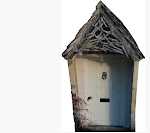 Alice's Adventures in Wonderland
Alice's Adventures in Wonderland is not really a fairy tale, but, like Peter Pan and the Oz books, it is often considered to be one of what
L. Frank Baum called the 'newer "wonder tales". But before I get properly started I have a confession to make. Alice is not one of my favourite tales, in fact far from it, but as there's no escaping Alice this week I wanted to collect together some of the many great Alice links I've come across.
My problem with Alice is the ending. Reading a beautiful
pop-up version with my sons over the last few days I've been reminded just how much I loved the stories as a child—until I got to the end. And Lewis Caroll does it to us not once but twice. In both stories we reach the dreaded waking. Why create such a wonderful reality only to destroy it with 'Wake up, Alice dear!' .... 'Why, what a long sleep you've had!'
No! Of course as an adult re-reading the books I can see all the metaphors and symbols. I can admit that we are told Alice is feeling very 'sleepy and stupid' and falling down the rabbit hole could be a metaphor for falling asleep... but the details: the sides of the well 'filled with cupboards and bookshelves...maps and pictures hung upon pegs'. As a child I read the story literally and I still want this to be an actual doorway into another world. Just as the back of the wardrobe was in
The Lion the Witch and the Wardrobe. These magical doorways were the most exciting thing to me about stories when I first began reading. There was the picture of the Dawntreader too, and when I was seven I had a teacher called Miss Jackson who told us wonderful tales of the Tockholes
Treacle Miners. Tockholes was a village near where we lived and the doorways into the miners' underground world were to be found in the landscape all around us (and I've looked out for them ever since). In
Through the Looking-Glass there is another magical entrance: the glass '
was beginning to melt away, just like a bright silvery mist' so that Alice could step through.
I just wish Caroll had provided a satisfying exit route from Wonderland too, rather than cheating us with it all having been a dream. But despite this, I await the
Tim Burton film, which reimagines the Alice stories, with glee. And in the meantime I'm enjoying revisiting Alice with my sons—the eldest keeps standing on the book, trying to get down the rabbit hole...
Digitised manuscripts and illustrations:Alice's Adventures Under Ground—the original manuscript as written and illustrated by Caroll, on the British Library site
Alice's Adventures in Wonderland (1866), as illustrated by John Tenniel
Alice's Adventures in Wonderland (1907), as illustrated by Arthur Rackham
Alice's Adventures in Wonderland and Through the Looking-Glass and what Alice Found There (1911)
Salvador Dali's illustrations (1969)
Illustrators of Alice on the webEarly films (available to watch online):Alice in Wonderland (1903) silent film by Cecil Hepworth
Alice in Wonderland (1915) silent film by W.W.Young
Interviews:Tim Burton interview on Radio 4—a brilliant interview, thanks to
Faye for the link.
Tim Burton and Johnny Depp on Friday Night with Jonathan Ross—a slightly more awkward interview, and as much as I love Johnny Depp I wish Ross had paid more attention to Tim Burton.
Interview with Mia Wasikowska, the new Alice, in The Times
Articles:There's something about Alice, AS Byatt in The Guardian—an engaging article which takes in a lot of other British children's classics but says less than I would have expected about Alice.
Innocence, obsession and the making of Alice in Wonderland, Peter Ackroyd in The Times—an interesting article about the history of the story and Dodgson himself.
Additional interesting links:A-Z of Alice in Wonderland — eclectic list of all things Alice from The Independent.
Info about
Alice in Sunderland — a fantastic looking Graphic Novel, thanks to Andy Hedgecock for the recommendation.
Illustration by Arthur Rackham 'At this the whole pack rose up into the air, and came flying down upon her' P158











